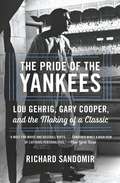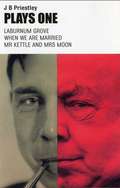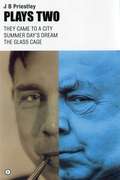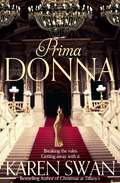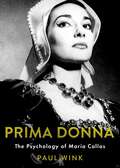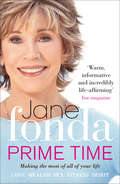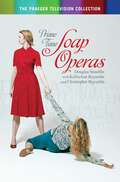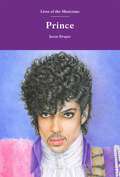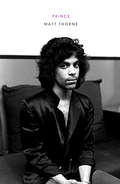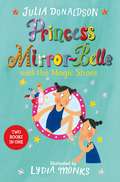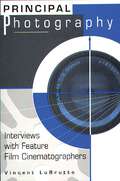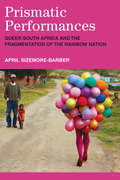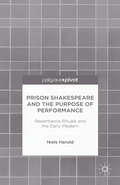- Table View
- List View
The Pride of the Yankees: Lou Gehrig, Gary Cooper, and the Making of a Classic
by Richard Sandomir"I CONSIDER MYSELF THE LUCKIEST MAN ON THE FACE OF THE EARTH." On July 4, 1939, baseball great Lou Gehrig delivered what has been called "baseball's Gettysburg Address" at Yankee Stadium and gave a speech that included the phrase that would become legendary. He died two years later and his fiery widow, Eleanor, wanted nothing more than to keep his memory alive. With her forceful will, she and the irascible producer Samuel Goldwyn quickly agreed to make a film based on Gehrig's life, The Pride of the Yankees. Goldwyn didn't understand -- or care about -- baseball. For him this film was the emotional story of a quiet, modest hero who married a spirited woman who was the love of his life, and, after a storied career, gave a short speech that transformed his legacy. With the world at war and soldiers dying on foreign soil, it was the kind of movie America needed. Using original scrips, letters, memos, and other rare documents, Richard Sandomir tells the behind-the-scenes story of how a classic was born. There was the so-called Scarlett O'Hara-like search to find the actor to play Gehrig; the stunning revelations Elanor made to the scriptwriter Paul Gallico about her life with Lou; the intensive training Cooper underwent to learn how to catch, throw, and hit a baseball for the first time; and the story of two now-legendary Hollywood actors in Gary Cooper and Teresa Wright whose nuanced performances endowed the Gehrigs with upstanding dignity and cemented the baseball icon's legend. Sandomir writes with great insight and aplomb, painting a fascinating portrait of a bygone Hollywood era, a mourning widow with a dream, and the shadow a legend cast on one of the greatest sports films of all time.
Priestley: Plays One (Oberon Modern Playwrights)
by J. B. PriestleyIncludes the plays Laburnum Grove, When We Are Married and Mr Kettle and Mrs MoonWith an introduction by Tom Priestley and a foreword by Roy Hattersley.These three domestic comedies display J B Priestley's talent for the ordinary situation turned sharply on its head. In Laburnum Grove George Radfern's friends and relations want a share of his wealth - until they find out where it's come from. When We Are Married features three high-minded couples who gather to celebrate their silver wedding anniversaries, only to discover they were never properly married at all.And in Mr Kettle and Mrs Moon an unassuming bank manager turns rebel when a voice tells him to pack in his position and stay at home.In these mischievous depictions of respectability gone awry, the proud and the prejudiced battle against emerging truths and potential scandal. J B Priestley proves himself a skilled craftsman and presents his characters with rich humour, warmth and humanity.
Priestley: Plays Two (Oberon Modern Playwrights)
by J. B. PriestleyIncludes the plays They Came to a City, Summer Day's Dream and The Glass CageWith an introduction by Tom Priestley.All three dramas in this second volume of J B Priestley's plays investigate the question of an individual's responsibility towards his or her family and community. In They Came to a City, written at the height of the Second World War, a mixed bag of Britons mysteriously find themselves outside a strange city. What kind of 'New Jerusalem' is this, and will it suit everybody?Summer Day's Dream, first performed in 1949, is set in the future - 1975. In a Britain bombed back into pre-industrial past, three representatives of the new world order disturb the tranquil lives of three generations of an English family. The themes of hypocrisy and redemption are brought to the fore in The Glass Cage, when three black sheep of a respectable Toronto clan are grudgingly welcomed back into the family home.
Prima Donna
by Karen SwanBreaking the rules was what she liked best. That was her sport. Renegade, rebel, bad girl. Getting away with it. Pia Soto is the sexy and glamorous prima ballerina, the Brazilian bombshell who's shaking up the ballet world with her outrageous behaviour. She's wild and precocious, and she's a survivor. She's determined that no man will ever control her destiny. But ruthless financier Will Silk has Pia in his sights, and has other ideas . . . Sophie O'Farrell is Pia's hapless, gawky assistant, the girl-next-door to Pia's Prima Donna, always either falling in love with the wrong man or just falling over. Sophie sets her own dreams aside to pick up the debris in Pia's wake, but she's no angel. When a devastating accident threatens to cut short Pia's illustrious career, Sophie has to step out of the shadows and face up to the demons in her own life.Prima Donna is an excitingly glamorous novel from Karen Swan, author of the bestselling Christmas at Tiffany's.
Prima Donna: The Psychology of Maria Callas (Inner Lives)
by Paul WinkPrima Donna: The Psychology of Maria Callas explores the psychological mechanisms underlying the hypnotic power of Callas's artistry and the unfolding of her tragic life story. Although precipitated by the trauma and shame that followed her abandonment by Aristotle Onassis and the rapid deterioration of her voice, Callas's midlife disintegration reflects deep psychological vulnerabilities. In this book, Wink utilizes cutting-edge advances in research on developmental psychology and narcissism to shed light on Callas's puzzling personal deterioration during the last nine years of her life. Lacking a cohesive and integrated sense of self, Callas sought affirmation and vitality from adoring audiences and older men including her husband Battista Meneghini and her long-term partner Onassis. The propensity to fuse her identity with stage roles contributed to her artistic greatness, but envy and the lack of an intrinsic sense of meaning and worth intensified her vulnerability to life's vicissitudes. Prima Donna is both a powerful study of Callas's life and a contribution to the greater body of work on the psychology of artists.
Prima Donna: The Psychology of Maria Callas (Inner Lives)
by Paul WinkPrima Donna: The Psychology of Maria Callas explores the psychological mechanisms underlying the hypnotic power of Callas's artistry and the unfolding of her tragic life story. Although precipitated by the trauma and shame that followed her abandonment by Aristotle Onassis and the rapid deterioration of her voice, Callas's midlife disintegration reflects deep psychological vulnerabilities. In this book, Wink utilizes cutting-edge advances in research on developmental psychology and narcissism to shed light on Callas's puzzling personal deterioration during the last nine years of her life. Lacking a cohesive and integrated sense of self, Callas sought affirmation and vitality from adoring audiences and older men including her husband Battista Meneghini and her long-term partner Onassis. The propensity to fuse her identity with stage roles contributed to her artistic greatness, but envy and the lack of an intrinsic sense of meaning and worth intensified her vulnerability to life's vicissitudes. Prima Donna is both a powerful study of Callas's life and a contribution to the greater body of work on the psychology of artists.
Prime Time: Love, Health, Sex, Fitness, Friendship, Spirit; Making the Most of All of Your Life
by Jane FondaJane Fonda, no. 1 bestselling author, actress and fitness pioneer, is an icon for generations of women. Now you can learn her secrets to living life to the full with this intimate insight into her world. Combining stories from her own life and from the lives of others with new research, Jane Fonda explores how the critical years from 45 and 50, and especially from 60 and beyond, can be the time when you truly become the energetic, loving, fulfilled person you were meant to be. Covering the 11 key ingredients for vital living, Fonda shows you how to enjoy a more insightful, healthy and fully integrated life - one that is profoundly in touch with yourself, your body, mind and spirit, and with your talents, friends and community. Covering health, fitness, sex, love, social growth, and self-understanding, Prime Time offers a vision for successful living and maturing, so you too can ensure that your forties and beyond are your own prime time.
Prime Time Animation: Television Animation and American Culture
by Carol StabileIn September 1960 a television show emerged from the mists of prehistoric time to take its place as the mother of all animated sitcoms. The Flintstones spawned dozens of imitations, just as, two decades later, The Simpsons sparked a renaissance of primetime animation. This fascinating book explores the landscape of television animation, from Bedrock to Springfield, and beyond.The contributors critically examine the key issues and questions, including: How do we explain the animation explosion of the 1960s? Why did it take nearly twenty years following the cancellation of The Flintstones for animation to find its feet again as primetime fare? In addressing these questions, as well as many others, essays examine the relation between earlier, made-for-cinema animated production (such as the Warner Looney Toons shorts) and television-based animation; the role of animation in the economies of broadcast and cable television; and the links between animation production and brand image. Contributors also examine specific programmes like The Powerpuff Girls, Daria, Ren and Stimpy and South Park from the perspective of fans, exploring fan cybercommunities, investigating how ideas of 'class' and 'taste' apply to recent TV animation, and addressing themes such as irony, alienation, and representations of the family.
Prime Time Animation: Television Animation and American Culture
by Carol StabileIn September 1960 a television show emerged from the mists of prehistoric time to take its place as the mother of all animated sitcoms. The Flintstones spawned dozens of imitations, just as, two decades later, The Simpsons sparked a renaissance of primetime animation. This fascinating book explores the landscape of television animation, from Bedrock to Springfield, and beyond.The contributors critically examine the key issues and questions, including: How do we explain the animation explosion of the 1960s? Why did it take nearly twenty years following the cancellation of The Flintstones for animation to find its feet again as primetime fare? In addressing these questions, as well as many others, essays examine the relation between earlier, made-for-cinema animated production (such as the Warner Looney Toons shorts) and television-based animation; the role of animation in the economies of broadcast and cable television; and the links between animation production and brand image. Contributors also examine specific programmes like The Powerpuff Girls, Daria, Ren and Stimpy and South Park from the perspective of fans, exploring fan cybercommunities, investigating how ideas of 'class' and 'taste' apply to recent TV animation, and addressing themes such as irony, alienation, and representations of the family.
Prime Time Soap Operas (The Praeger Television Collection)
by Douglas M. SnaufferPrime time soaps are often revered long after their runs on television have ended, as Dallas, Twin Peaks, and Beverly Hills 90210 readily demonstrate. Due to their profound impact, it's easy to forget how recently the genre itself was born. Dallas premiered in 1978, and was originally intended to air solely as a five-part mini-series. Then, in 1981, producer Aaron Spelling stepped in and introduced his own ultra-glitzy entry Dynasty. Between these two mega-hits, the era of the nighttime soap was born. Soaps soon spun off into non-traditional avenues as well, in sitcoms like Filthy Rich and the supernatural drama Twin Peaks. Then, with the arrival of the more youth-oriented Fox Network, producers were able to hook an entirely new generation on programs such as Beverly Hills, 90210, Melrose Place, and Party of Five. Pay-cable channels have also stepped into the picture and now act as trendsetters with hits like Sex and the City, Six Feet Under, The Sopranos, and The L Word. Now, from the spiritually themed 7th Heaven to the naughty neighbors of ABC's Desperate Housewives, soaps dominate prime time. Prime Time Soaps covers all the major shows within the soap-opera genre, and also investigates all the ways that soaps have contributed to the development of more general television trends. Interviews with producers, actors, and other artistic collaborators also supplement this revealing and entertaining account.Even outside of their genre, these shows continue to influence current programming. Few series on TV today are purely episodic, instead containing on-going storylines involving the personal dilemmas of their characters. Another very recognizable contribution from soaps occurred on the evening of March 21, 1980, when Dallas finished out its third year with J.R. Ewing being shot by an unknown assailant, leaving fans to wait until the fall for the resolution. This was the beginning of the cliffhanger endings that are now implemented by just about every series on television. Prime Time Soaps covers all the major shows, and also investigates all the ways that soaps have contributed to the development of more general television trends. Interviews with producers, actors, and other artistic collaborators supplement this revealing and entertaining account.
Prime Time Soap Operas (The Praeger Television Collection)
by Douglas M. SnaufferPrime time soaps are often revered long after their runs on television have ended, as Dallas, Twin Peaks, and Beverly Hills 90210 readily demonstrate. Due to their profound impact, it's easy to forget how recently the genre itself was born. Dallas premiered in 1978, and was originally intended to air solely as a five-part mini-series. Then, in 1981, producer Aaron Spelling stepped in and introduced his own ultra-glitzy entry Dynasty. Between these two mega-hits, the era of the nighttime soap was born. Soaps soon spun off into non-traditional avenues as well, in sitcoms like Filthy Rich and the supernatural drama Twin Peaks. Then, with the arrival of the more youth-oriented Fox Network, producers were able to hook an entirely new generation on programs such as Beverly Hills, 90210, Melrose Place, and Party of Five. Pay-cable channels have also stepped into the picture and now act as trendsetters with hits like Sex and the City, Six Feet Under, The Sopranos, and The L Word. Now, from the spiritually themed 7th Heaven to the naughty neighbors of ABC's Desperate Housewives, soaps dominate prime time. Prime Time Soaps covers all the major shows within the soap-opera genre, and also investigates all the ways that soaps have contributed to the development of more general television trends. Interviews with producers, actors, and other artistic collaborators also supplement this revealing and entertaining account.Even outside of their genre, these shows continue to influence current programming. Few series on TV today are purely episodic, instead containing on-going storylines involving the personal dilemmas of their characters. Another very recognizable contribution from soaps occurred on the evening of March 21, 1980, when Dallas finished out its third year with J.R. Ewing being shot by an unknown assailant, leaving fans to wait until the fall for the resolution. This was the beginning of the cliffhanger endings that are now implemented by just about every series on television. Prime Time Soaps covers all the major shows, and also investigates all the ways that soaps have contributed to the development of more general television trends. Interviews with producers, actors, and other artistic collaborators supplement this revealing and entertaining account.
Prince (Lives of the Musicians)
by Jason DraperHis name was Prince, and he was funky. He was also inspiring, infuriating, visionary and otherworldly. Channelling contradictions in search of his own unique truth, he eventually changed his name to an unpronounceable glyph that merged the male and female symbols in an outward expression of his inner dualities. Gifted with the ability to play almost every instrument on his records, and shifting between musical styles as much as he switched-up his looks, he refused to acknowledge boundaries. Instead, he brought opposing forces together in a life-long quest to reconcile a dirty mind with a love for God. In doing so, the mini Minneapolis genius became a world-conquering icon whose towering legacy continues to shape pop culture.
Prince: The Man And His Music
by Matt ThorneLegendarily reticent, perverse and misleading, Prince is one of the few remaining 80s superstars who still, perhaps, remains unexplained. Now a firm fixture in the pop canon, where such classics as 'Purple Rain', 'Sign o' the Times' and 'Parade' regularly feature in Best Ever Album polls, Prince is still, as he ever was, an enigma. His live performances are legendary (21 Nights at the O2 in 2007) and while recent releases have been modestly successful at best, his influence on urban music, and R'n'B in particular, has never been more evident. The Minneapolis Sound can now be heard everywhere. Matt Thorne's Prince, through years of research and interviews with ex-Revolution members such as Wendy and Lisa, is an account of a pop maverick whose experiments with rock, funk, techno and jazz revolutionised pop. With reference to every song, released and unreleased, over 35 years of recording, Prince will stand for years to come as the go-to book on the Great Man.
Prince: Purple Reign
by Mick WallPrince was an icon. A man who defined an era of music and changed the shape of popular culture forever. There is no doubt that he was one of the most talented and influential artists of all time, and also one of the most mysterious. On 21st April 2016 the world lost its Prince; it was the day the music died.This book will open a door to Prince's world like never before - from his traumatic childhood and demonic pursuit of music as a means of escape, to his rise to superstardom, professional rivalries and marriages shrouded in tragedy, internationally bestselling music writer Mick Wall explores the historical, cultural and personal backdrop that gave rise to an artist the likes of which the world has never seen - and never will again.Mick, a lifelong Prince fan, was one of the first UK journalists to ever write about this enigmatic star, and it was his story that put Prince on the cover of Kerrang magazine in 1984 and inspired the biggest mailbag of letters the magazine has ever had. As Prince sang in '7', 'no one in the whole universe will ever compare', and this book is a shining tribute to the forever incomparable Prince.
The Princess Diarist
by Carrie FisherWhen Carrie Fisher discovered the journals she kept during the filming of the first Star Wars movie, she was astonished to see what they had preserved - plaintive love poems, unbridled musings with youthful naiveté, and a vulnerability that she barely recognized. Now her fame as an author, actress, and pop-culture icon is indisputable, but in 1977, Carrie Fisher was just a teenager with an all-consuming crush on her co-star, Harrison Ford. With these excerpts from her handwritten notebooks, The Princess Diarist is Fisher’s intimate and revealing recollection of what happened on one of the most famous film sets of all time – and what developed behind the scenes. Fisher also ponders the joys and insanity of celebrity, and the absurdity of a life spawned by Hollywood royalty, only to be surpassed by her own outer-space royalty. Laugh-out-loud hilarious and endlessly quotable, The Princess Diarist brims with the candour and introspection of a diary while offering shrewd insight into the type of stardom that few will ever experience.
Princess Mirror-Belle and the Magic Shoes: Princess Mirror-Belle Bind Up 2 (Princess Mirror-Belle #3)
by Julia DonaldsonFrom Julia Donaldson, the bestselling author of The Gruffalo, comes Princess Mirror-Belle and the Magic Shoes, the exciting adventures of a mischievous princess. Full of black-and-white illustrations by Lydia Monks, Princess Mirror-Belle and The Magic Shoes is perfect for fans of this bestselling picture book team who are beginning to read on their own. This bind-up of two fantastic books, Princess Mirror-Belle and The Magic Shoes and Princess Mirror-Belle and Prince Precious Paws, contains five delightful stories that children will come back to again and again.Ellen's life is turned upside down by the hilarious Mirror-Belle, a spirited princess who claims to be from somewhere mysterious and far away. She appears out of mirrors to tell Ellen magical stories and take her on exciting escapades. From going to ballet class to staying at Ellen's grandparents' house, causing mischief with their furry friends, having fun at Halloween and taking the princess test, you can always guarantee that wherever Mirror-Belle goes, trouble will follow.
Princess Mononoke: Understanding Studio Ghibli's Monster Princess (Animation: Key Films/Filmmakers)
by Rayna DenisonPrincess Mononoke (1997) is one of anime's most important films. Hayao Miyazaki's epic fantasy broke domestic box office records when it came out in Japan, keeping pace with the success of Hollywood films like Titanic (1997). Princess Mononoke was also the first of Studio Ghibli's films to be distributed outside Japan as part of a new deal with Disney subsidiary Buena Vista International. Coinciding with the 20th anniversary of the release of the film, Rayna Denison curates this new collection to critically reflect on Princess Mononoke's significance within and beyond Japanese culture. The collection investigates the production, and re-production, processes involved in the making of Princess Mononoke into a global phenomenon and reevaluates the film's significance within a range of global markets, animation techniques, and cultures.In revisiting this undeniably important film, the collection sheds light on the tensions within anime and the cultural and social issues that Princess Mononoke explores, from environmental protection to globalization to the representation of marginalized groups. In this remarkable new collection, Princess Mononoke is examined as a key player during a major turning point in Japanese animation history.
Princess Poppy: Ballet Dreams (Princess Poppy Fiction #7)
by Janey Louise Jones Samantha ChaffeyPoppy and Honey are thrilled when Madam Angelwing starts advanced ballet classes. At first, Poppy loves the extra lessons, but soon gives them up when she begins to feel that ballet is taking over her life. Honey decides to stick with the classes as Madam has told her she's good enough to be a professional ballerina when she grows up.Now, when Honey isn't at dance class she's either practicing ballet or reading about it - she just doesn't have any time for Poppy anymore. Will Honey's ballet dreams come true? And will things ever be the same between Poppy and Honey?
Principal Photography: Interviews with Feature Film Cinematographers
by Vincent LoBruttoBy using photography as a storytelling medium, the cinematographer plays a key role in translating a screenplay into images and capturing the director's vision of a film. This volume presents in-depth interviews with 13 prominent cinematographers, who discuss their careers and the art and craft of feature film cinematography. The interviewees—who represent the spectrum of big-budget Hollywood and low-budget independent filmmaking from the sixties through the nineties—talk about their responsibilities, including lighting, camera movement, equipment, cinematic grammar, lenses, film stocks, interpreting the script, the budget and schedule, and the psychological effect of images. Each interview is preceded by a short biography and a selected filmography, which provide the background for a detailed analysis of the photographic style and technique of many highly acclaimed and seminal films.
The Principles of Movement (The Actor's Toolkit)
by Michael Campbell Keith BainWith contributions by Cate Blanchett, Geoffrey Rush, Baz Luhrmann, Miranda Otto and Hugo Weaving amongst others. From the writings of Keith Bain, Michael Campbell has collated a step-by-step course for students and teachers on the principles and practice of Australia’s great teacher of Movement. In simple language he lays out the secrets of self-knowledge that lie behind understanding the body and mind. ‘Movement’, says Bain, ‘is both how we move and what moves us, Movement is the look in our eyes, the tensions and the tone in our muscles, our breathing, our thinking, our longings and fears. Movement has equal concern for the inner and outer aspects, with each clarifying the other.’
Prismatic Media, Transnational Circuits: Feminism in a Globalized Present (Global Cinema)
by K. LynesWhat are the political and aesthetic dimensions of video art, documentary, and global cinema in contemporary image culture? Lynes makes visible how sites of political struggle, exploitation, and armed conflict can be interpreted through a feminist politics of location, attentive to the frictions and flows within transnational circuits of exchange.
Prismatic Performances: Queer South Africa and the Fragmentation of the Rainbow Nation (Triangulations: Lesbian/Gay/Queer Theater/Drama/Performance)
by April Sizemore-BarberAt his 1994 inauguration, South African president Nelson Mandela announced the “Rainbow Nation, at peace with itself and the world.” This national rainbow notably extended beyond the bounds of racial coexistence and reconciliation to include “sexual orientation” as a protected category in the Bill of Rights. Yet despite the promise of equality and dignity, the new government’s alliance with neoliberal interests and the devastation of the AIDS epidemic left South Africa an increasingly unequal society. Prismatic Performances focuses on the queer embodiments that both reveal and animate the gaps between South Africa’s self-image and its lived realities. It argues that performance has become a key location where contradictions inherent to South Africa’s post-apartheid identity are negotiated. The book spans 30 years of cultural production and numerous social locations and includes: a team of black lesbian soccer players who reveal and redefine the gendered and sexed limitations of racialized “Africanness;” white gay performers who use drag and gender subversion to work through questions of racial and societal transformation; black artists across the arts who have developed aesthetics that place on display their audiences’ complicity in the problem of sexual violence; and a primarily heterosexual panAfrican online soap opera fandom community who, by combining new virtual spaces with old melodramatic tropes allow for extended deliberation and new paradigms through which African same-sex relationships are acceptable. Prismatic Performances contends that when explicitly queer bodies emerge onto public stages, audiences are made intimately aware of their own bodies’ identifications and desires. As the sheen of the New South Africa began to fade, these performances revealed the inadequacy and, indeed, the violence, of the Rainbow Nation as an aspirational metaphor. Simultaneously they created space for imagining new radical configurations of belonging.
The Prison of Time: Stanley Kubrick, Adrian Lyne, Michael Bay and Quentin Tarantino
by Elisa PezzottaWe are imprisoned in circadian rhythms, as well as in our life reviews that follow chronological and causal links. For the majority of us our lives are vectors directed toward aims that we strive to reach and delimited by our birth and death. Nevertheless, we can still experience fleeting moments during which we forget the past and the future, as well as the very flow of time. During these intense emotions, we burst out laughing or crying, or we scream with pleasure, or we are mesmerized by a work of art or just by eyes staring at us. Similarly, when we watch a film, the screening time has a well defined beginning and end, and screening and diegetic time and their relations, together with narrative and stylistic techniques, determine a time within the time of our life with its own rules and exceptions. Through the close analysis of Stanley Kubrick's, Adrian Lyne's, Michael Bay's and Quentin Tarantino's oeuvres, this book discusses the overall 'dominating' time of their films and the moments during which this 'ruling' time is disrupted and we momentarily forget the run toward the diegetic future – suspense – or the past – curiosity and surprise. It is in these very moments, as well as in our own lives, that the prison of time, through which the film is constructed and that is constructed by the film itself, crumbles displaying our role as spectators, our deepest relations with the film.
The Prison of Time: Stanley Kubrick, Adrian Lyne, Michael Bay and Quentin Tarantino
by Elisa PezzottaWe are imprisoned in circadian rhythms, as well as in our life reviews that follow chronological and causal links. For the majority of us our lives are vectors directed toward aims that we strive to reach and delimited by our birth and death. Nevertheless, we can still experience fleeting moments during which we forget the past and the future, as well as the very flow of time. During these intense emotions, we burst out laughing or crying, or we scream with pleasure, or we are mesmerized by a work of art or just by eyes staring at us. Similarly, when we watch a film, the screening time has a well defined beginning and end, and screening and diegetic time and their relations, together with narrative and stylistic techniques, determine a time within the time of our life with its own rules and exceptions. Through the close analysis of Stanley Kubrick's, Adrian Lyne's, Michael Bay's and Quentin Tarantino's oeuvres, this book discusses the overall 'dominating' time of their films and the moments during which this 'ruling' time is disrupted and we momentarily forget the run toward the diegetic future – suspense – or the past – curiosity and surprise. It is in these very moments, as well as in our own lives, that the prison of time, through which the film is constructed and that is constructed by the film itself, crumbles displaying our role as spectators, our deepest relations with the film.
Prison Shakespeare and the Purpose of Performance: Repentance Rituals And The Early Modern
by N. HeroldOver the last decade a number of prison theatre programs have developed to rehabilitate inmates by having them perform Shakespearean adaptations. This book focuses on how prison theatre today reveals certain elements of the early modern theatre that were themselves responses to cataclysmic changes in theological doctrine and religious practice.
